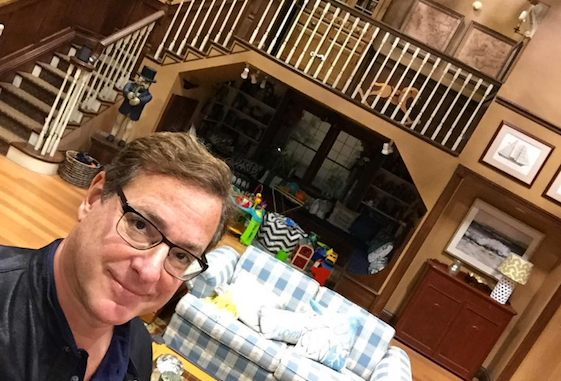
When people think of Full House, they typically remember the warm, funny moments and the tight-knit Tanner family, who always had each other’s backs no matter what. However, when compared to its modern counterpart, Fuller House, Full House had some surprisingly dark and heavy storylines that often flew under the radar. While Fuller House embraced more light-hearted, family-friendly themes, its predecessor wasn’t afraid to dive into heavier issues, tackling topics like grief, substance abuse, and dysfunctional relationships.
In this article, we’ll highlight 5 stories from Full House that reveal just how much darker the original show was compared to Fuller House. These episodes delved into real-world issues with serious consequences—moments that might make you think differently about this beloved 80s/90s sitcom.
1. The Death of a Parent: The Heart-Wrenching Beginning of the Series
The Tragic Loss That Shaped the Tanner Family
The very foundation of Full House starts with one of the darkest storylines in television history: the death of Danny Tanner’s wife, Pam. Pam’s death is never shown, but the impact of her passing is felt throughout the entire series. Danny is left to raise his three daughters, DJ, Stephanie, and Michelle, with the help of his brother-in-law Jesse and his best friend Joey. The grief from losing Pam is a constant undercurrent of the series, influencing how Danny navigates life and how the girls cope with their mother’s absence.
While Fuller House also touches on the themes of loss, particularly DJ’s husband Tommy’s death, the gravity of Pam’s death was often a somber reminder of the real-world struggles that families face. In Fuller House, the focus is more on moving forward after loss, while Full House makes it clear that grief can last for years and affect every aspect of life.
2. Joey’s Struggles with His Career and Love Life
Joey Gladstone’s Unresolved Personal Issues
While Joey Gladstone is often the comic relief on Full House, his personal life is far from lighthearted. Throughout the series, Joey struggles with feelings of failure and insecurity about his career as a comedian, as well as his relationships. He’s constantly trying to find his place in the world and struggling with whether or not he will ever “make it.” At times, Joey seems unsure of his future, which creates a stark contrast to the more upbeat, family-friendly tone of the show.
In one notable episode, “Joey’s Funny Valentine” (Season 2, Episode 18), Joey faces the heartbreaking reality that he’s not the success he imagined he would be. He’s constantly overlooked and passed over in favor of more popular comedians. His inability to sustain a successful romantic relationship also presents a darker side to his character, reflecting the emotional toll of feeling left out and not good enough.
While Fuller House presents Joey in a more positive light, focusing on his role as a doting father and an established comedian, Full House never shied away from showing the struggles he faced as an adult still trying to find his footing in a world that didn’t always appreciate him.

3. The Episode Where Danny Struggles with Substance Abuse
“Just Say No”: A Rarely Discussed Storyline
In Full House Season 3, Episode 16 (“Just Say No”), a storyline emerges that reflects a real-world issue that many families face: drug and alcohol abuse. In this episode, Danny is shown confronting the temptation to use alcohol as a means of coping with stress and the challenges of raising three daughters. After a particularly rough day, he reaches for a bottle of wine and even gets drunk, leaving his children to witness his breakdown.
This episode is surprisingly dark for a show known for its light-hearted, feel-good moments. It emphasizes the dangers of substance abuse and how it can deeply affect not only the individual but their loved ones as well. While Fuller House never directly addresses such issues, Full House was unafraid to explore difficult topics like addiction, particularly in ways that illustrated how families could support each other through hard times.
4. Jesse’s Dark Past with His Father and His Identity Crisis
The Complex Relationship Between Jesse and His Father
Jesse Katsopolis, one of the fan-favorite characters, often had a carefree and fun-loving demeanor. However, his character arc is filled with moments of personal turmoil. His relationship with his father, in particular, is complicated, and it plays a key role in shaping who Jesse becomes as an adult. In Full House, it is revealed that Jesse’s father was emotionally distant and had a strained relationship with his son. Jesse struggles with feelings of abandonment and the constant pressure to live up to his father’s expectations, which sometimes leads him to question his worth.
In the Season 6 episode “The Struggle Is On” (Season 6, Episode 6), Jesse is forced to confront his past when his father returns to San Francisco. Their emotional confrontation sheds light on the darker side of Jesse’s personality and his struggle with self-identity and forgiveness.
Though Fuller House touches on Jesse’s growth as a father and a husband, it doesn’t delve deeply into his past struggles in the same way that Full House does. The original series wasn’t afraid to explore deep emotional scars and their long-lasting effects on individuals.
5. Stephanie’s Struggles with Bullying and Body Image Issues
The Pressure of Being the “Middle Child”
While Stephanie Tanner was often portrayed as the spunky, fun-loving middle child, her character also faced her own set of personal struggles. One of the darker aspects of Full House was how it addressed issues related to self-esteem and body image. In Season 6, Episode 25, titled “The Day of the Rhino,” Stephanie is bullied at school for being overweight. This story is a poignant moment in the series, showing the pressures that children face when it comes to their appearance and how bullying can deeply affect their mental health.
Throughout the episode, Stephanie learns valuable lessons about confidence and how to love herself, but the emotional toll that bullying takes on her is a stark and serious issue for a show that is generally light-hearted. Fuller House doesn’t touch on such heavy topics as directly, opting instead for more comedic and optimistic moments.
Conclusion: The Hidden Darkness of Full House
While Full House is often remembered for its wholesome family values, the show was no stranger to addressing real-world issues with depth and gravity. From grief and loss to substance abuse and bullying, Full House wasn’t afraid to explore darker, more serious themes that many families could relate to. These episodes reminded viewers that family isn’t just about fun and laughter—it’s also about supporting each other through life’s toughest moments.
Fuller House embraced a much lighter tone, focusing more on the comedic and happy aspects of life, but Full House took risks by confronting issues that families often face. These 5 stories prove that the original show had a darker side that added layers to its characters and gave it an emotional depth that is often overlooked.
FAQs
1. Did Full House address any mental health issues? Yes, Full House explored issues like grief, stress, and self-esteem. For example, Danny struggles with alcoholism in the episode “Just Say No,” while Stephanie faces bullying and body image concerns in several episodes.
2. Why was Full House considered darker than Fuller House? Full House tackled real-world issues like addiction, loss, and emotional trauma in a way that Fuller House did not. While Fuller House kept things lighter and more comedic, Full House often addressed deeper, more serious topics.
3. How did Jesse’s past affect his relationship with his father? Jesse had a strained relationship with his father, who was emotionally distant and difficult to please. Their confrontations in Full House revealed Jesse’s unresolved pain and need for closure, providing a darker, more complex layer to his character.
4. What was the significance of the “Just Say No” episode in Full House? This episode dealt with Danny’s struggle with alcohol as a means of coping with stress, showing how addiction can affect both the person and their family. It highlighted the seriousness of substance abuse in a family-friendly show.
5. How did Full House handle the topic of bullying? In Full House, Stephanie faced bullying over her body image, which led to a storyline about self-esteem and confidence. It addressed the emotional impact of bullying in a way that resonated with many viewers.
